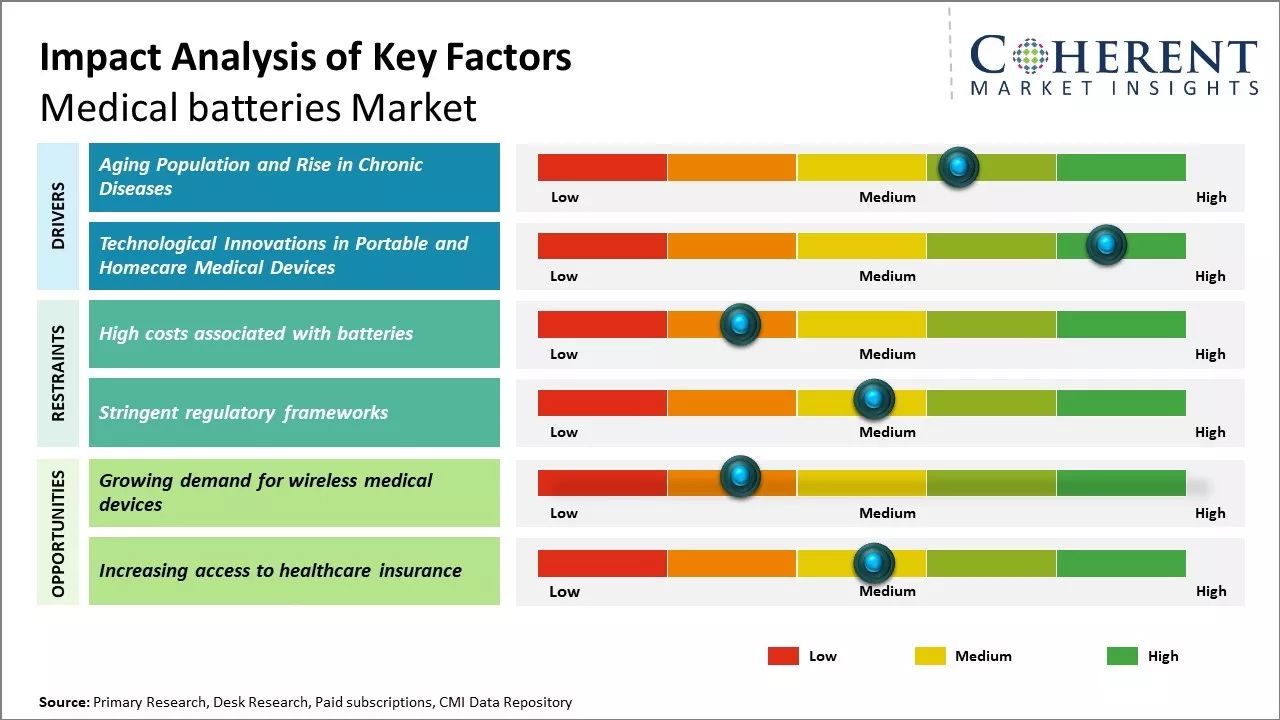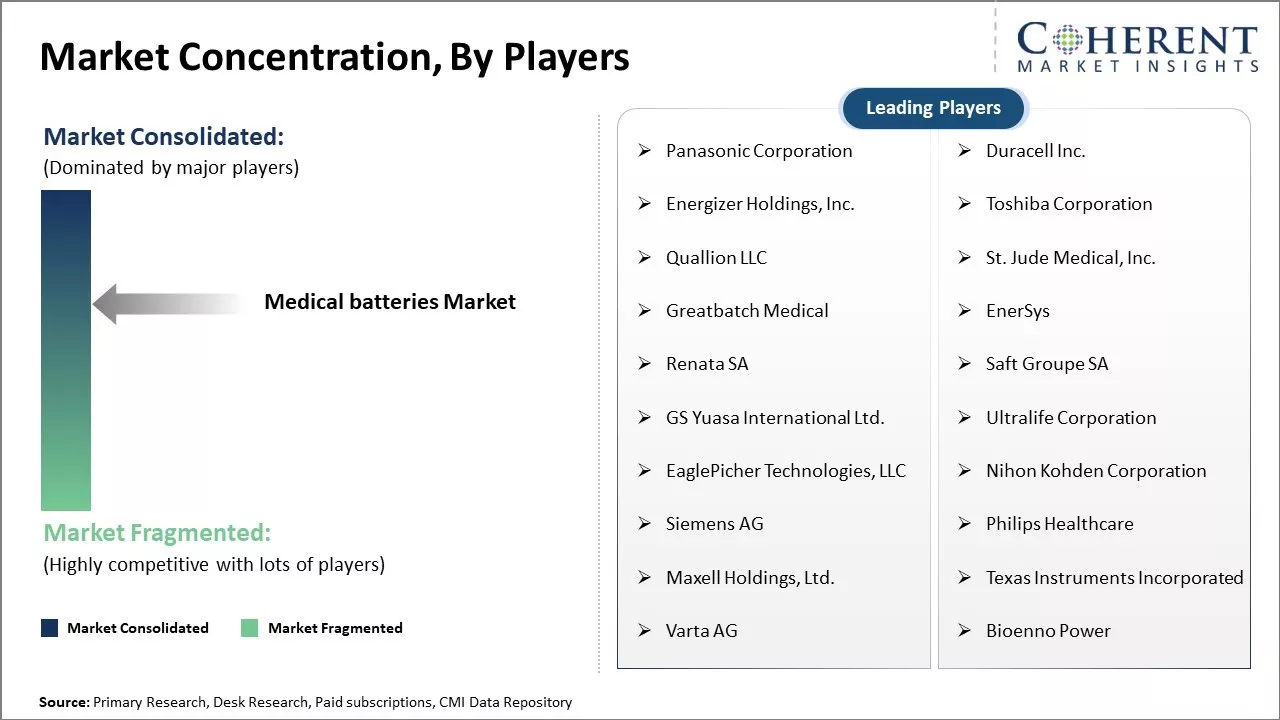The global medical batteries market is estimated to be valued at USD 2.98 Bn in 2025 and is expected to reach USD 4.64 Bn by 2032, exhibiting a compound annual growth rate (CAGR) of 6.5% from 2025 to 2032.
The market is witnessing increased demand for long-lasting batteries from the healthcare sector and the growing sales of portable medical devices. The market is driven by factors such as the increasing prevalence of chronic diseases that require medical devices, rising sales of home healthcare devices, growing demand for longer-lasting batteries, and technological advancements in battery technologies.
Moreover, increasing healthcare investments and rising disposable incomes in emerging economies are expected to create lucrative opportunities for players in the medical batteries market during the forecast period.

To learn more about this report, Download Free Sample

To learn more about this report, Download Free Sample
|
Current Events |
Description and its impact |
|
Global Push for Renewable Energy and Sustainability Initiatives
|
|
|
Geopolitical Conflicts and Supply Chain Disruptions (Russia-Ukraine Conflict & China-U.S. Trade Tensions) |
|
Uncover macros and micros vetted on 75+ parameters: Get instant access to report
The global medical batteries market is expanding rapidly due to the aging population and the increasing prevalence of chronic diseases, which elevate the demand for battery-powered medical devices.
For instance, cardiovascular diseases remain the leading cause of death globally, with approximately 17.9 million fatalities annually. Additionally, diabetes affects over 589 million adults worldwide, with projections indicating a rise to 853 million by 2050. These conditions necessitate the use of medical devices such as pacemakers, insulin pumps, and portable oxygen concentrators, all of which rely on efficient battery systems.
Technological advancements in portable and homecare medical devices are boosting the global medical batteries market, driven by growing use of wearable monitors and remote patient care tools. Devices like glucose monitors, insulin pumps, and portable ECGs need small, lightweight, long-lasting batteries, with lithium-ion batteries being the preferred choice due to their high energy density.
Recent research by the U.S. Department of Energy has developed cobalt-free lithium-ion batteries with silicon-carbon composites that could triple storage capacity, potentially extending device runtimes significantly if commercialized.
The healthcare sector has seen tremendous growth in wireless medical technologies over the past few years. Devices such as wireless blood pressure monitors, glucose monitors, ECG monitors, and implantable cardiac devices have revolutionized patient care by enabling remote and continuous monitoring. This shift towards wireless connected care comes with an increased need for higher capacity, longer lasting and portable power sources. Medical devices now require sophisticated batteries that can withstand years of continuous use inside the human body or power devices for days on a single charge. As new, more advanced wireless medical gadgets hit the market, their miniaturized nature and constant power demands will further stimulate demand for specialized high-quality medical batteries.
In terms of usage, implantable devices batteries segment is expected to contribute the highest share of 60.5% in 2025 owing to rapid technological advancements and growing patient acceptance of implantable devices.
Implantable medical devices such as pacemakers, defibrillators, and neurostimulators require long-lasting power sources to function optimally while implanted inside the body. Lithium batteries are the preferred option for most implantable devices due to their high energy density, lightweight design, and ability to provide power for 5-7 years on a single charge. With new technologies on the horizon like brain-computer interfaces, the demand for implantable batteries are expected to grow steadily.
In terms of battery type, lithium batteries segment is expected to contribute the highest share of 40.62% in 2025 owing to their superior performance attributes.
Lithium battery chemistry provides two to three times higher energy density compared to other battery types like nickel-metal hydride. This allows device designers to pack more power into miniature battery sizes without compromising runtime. Continuous R&D is focused on improving lithium battery formulation to achieve even higher energy and power density levels. Stringent battery testing ensures lithium power sources meet safety and long-term reliability requirements for medical applications.
In terms of end user, hospitals and nursing homes segment is expected to contribute the highest share of 49.62% in 2025.
Healthcare facilities utilize vast amounts of medical batteries to power diagnostic equipment, emergency response devices, patient monitoring systems, and other technology used for round-the-clock patient care. Strict regulations regarding emergency preparedness and business continuity planning also mandate uninterrupted power backup for healthcare facilities. Their budget allocations towards procuring medical batteries, especially high-capacity lithium batteries, continue growing year-over-year to ensure smooth operation during power outages. Online procurement is gaining popularity among hospital procurement teams seeking bulk discounts.

To learn more about this report, Download Free Sample
North America has established itself as the dominant region in the global medical batteries market. The region is expected to account for a share of 33.6% in 2025. Additionally, the region is an early adopter of new medical technologies due to higher patient affordability, which drives the need for supportive battery technologies.
The region has a conducive regulatory environment that supports such product development. These factors have allowed North America to account for the largest share in the global medical batteries market.
The Asia Pacific region has emerged as the fastest growing market for medical batteries. Rapid economic development and growing population have increased the burden of diseases across developing nations like India and China.
This has prompted governments to prioritize healthcare infrastructure and services. The heavy investments are enabling greater access to advanced medical facilities and improved healthcare coverage. Consequently, the usage of medical equipment powered by batteries is surging tremendously.
The U.S. medical batteries market is growing steadily due to rising chronic diseases and an aging population increasing demand for portable and homecare devices. Advancements in battery technology, including lithium-ion and solid-state batteries, are improving device reliability and performance. The trend toward remote patient monitoring further drives the need for efficient, long-lasting batteries. Overall, innovation and healthcare needs are key factors shaping market growth.
The India medical batteries market is growing steadily due to an aging population and more people with chronic illnesses, which increases the need for battery-powered medical devices.
Recent efforts, like IIT Madras opening India’s first mobile medical device calibration center in 2024, show the country’s focus on improving healthcare and medical device support. Also, Panasonic Energy is working with IOCL to set up a factory for lithium batteries to meet the growing demand in India. These developments highlight the market’s strong potential.
| Report Coverage | Details | ||
|---|---|---|---|
| Base Year: | 2024 | Market Size in 2025: | USD 2.98 Bn |
| Historical Data for: | 2020 To 2024 | Forecast Period: | 2025 To 2032 |
| Forecast Period 2025 to 2032 CAGR: | 6.5% | 2032 Value Projection: | USD 4.64 Bn |
| Geographies covered: |
|
||
| Segments covered: |
|
||
| Companies covered: |
Panasonic Corporation, Duracell Inc., Energizer Holdings, Inc., Toshiba Corporation, Quallion LLC, St. Jude Medical, Inc., Greatbatch Medical, EnerSys, Renata SA, Saft Groupe SA, GS Yuasa International Ltd., Ultralife Corporation, EaglePicher Technologies, LLC, Nihon Kohden Corporation, Siemens AG, Philips Healthcare, Maxell Holdings, Ltd., Texas Instruments Incorporated, Varta AG, and Bioenno Power |
||
| Growth Drivers: |
|
||
| Restraints & Challenges: |
|
||
Uncover macros and micros vetted on 75+ parameters: Get instant access to report
Panasonic manufactures specialized lithium-ion and nickel-metal hydride batteries at its facilities in Osaka (Japan), Dalian (China), and Nevada (U.S.). Its production is primarily focused on powering implantable medical devices such as pacemakers, as well as various diagnostic equipment.
EnerSys Inc. operates major manufacturing hubs in Reading, Pennsylvania (U.S.), Birmingham (U.K.), and Shanghai (China). The company's production is centered on lithium-based and zinc-air batteries, which are largely used in portable medical devices. EnerSys Inc. highlights its scalable production capabilities, reporting an annual output exceeding 50 million units specifically for healthcare applications.
*Definition: The global medical batteries market involves the manufacturing, development, and sale of rechargeable and non-rechargeable batteries that are used to power medical equipment and devices. This includes batteries used in devices like mobility aids, surgical equipment, personal medical devices, implantable medical devices and other healthcare appliances. The medical batteries market is driven by the aging population, growing number of people suffering from chronic diseases and improvements in healthcare infrastructure across the world which has increased the demand for medical devices needing reliable battery power.
Share
Share
About Author
Komal Dighe is a Management Consultant with over 8 years of experience in market research and consulting. She excels in managing and delivering high-quality insights and solutions in Health-tech Consulting reports. Her expertise encompasses conducting both primary and secondary research, effectively addressing client requirements, and excelling in market estimation and forecast. Her comprehensive approach ensures that clients receive thorough and accurate analyses, enabling them to make informed decisions and capitalize on market opportunities.
Missing comfort of reading report in your local language? Find your preferred language :
Transform your Strategy with Exclusive Trending Reports :
Frequently Asked Questions
Joining thousands of companies around the world committed to making the Excellent Business Solutions.
View All Our Clients